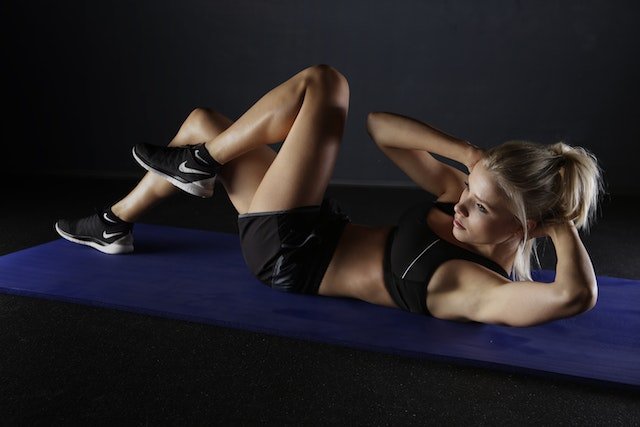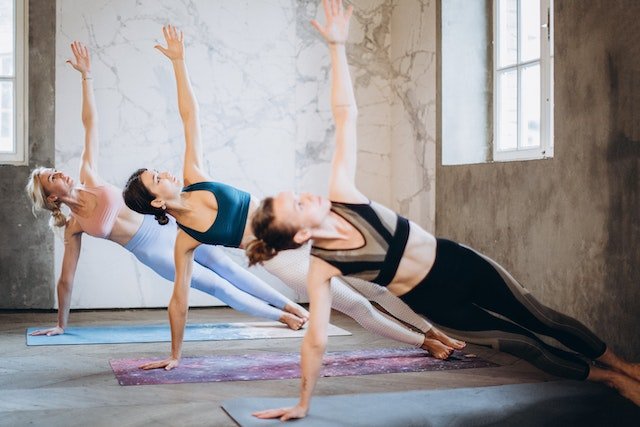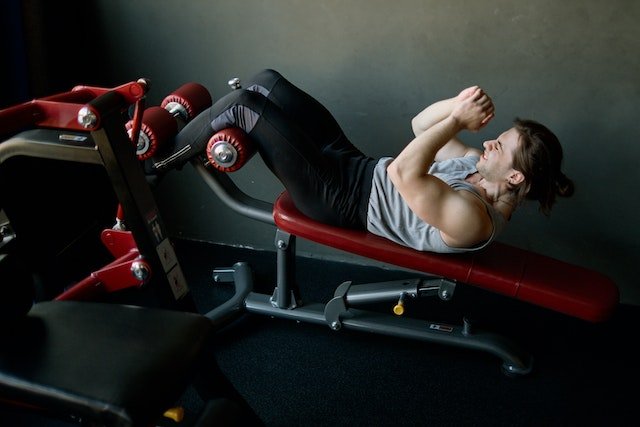
Why Do My Hip Flexors Hurt When I Do Ab Workouts? 16 Tips To Fix The Issue
If you’ve been working out for a while, chances are you’ve experienced some pain in your hip flexors.
You’re not alone – many people experience this type of pain when they do abdominal exercises.
Its strange because you dont have the issue when you do other exercises. So why does ab exercise cause hip flexor pain?
There can be several factors involved in this common issue and it’s best to get to the bottom of what’s causing your pain, so you can carry on working out pain free.
So what’s causing it, and more importantly, what can you do about it? Keep reading to find out.
Why Do My Hip Flexors Hurt When I Do Ab workouts?
Your hip flexors can hurt when doing ab exercises for various reasons, because the hip flexors are connected to your core and the muscles can become weak if not used properly. When you do ab exercises, such as crunches, the hip flexors are in a shortened position. This tightens them and can lead to imbalances which cause pain. If you’re overweight, it can add additional strain on your hip flexors, as they are supporting more weight than they should. It’s also important to make sure you have good form when doing ab exercises, as poor form can cause further strain. If your core and hip flexors are weak, they won’t be able to handle the stress of the exercise. This can lead to pain and discomfort, as your body is unable to support the exercise correctly. If you’re new to training or have been sedentary for a while, it’s best to start slowly and build up gradually. If you try to do too much too quickly, this can lead to overtraining, which can cause pain and injury. It’s also important to vary your ab exercises, as doing the same movements over and over again can cause the same muscles to become overly tight. If you’re still experiencing hip flexor pain, it’s best to seek advice from a health professional to get to the bottom of what could be causing it.
Symptoms of hip flexor issues
There are a few common symptoms that can indicate you have a hip flexor issue.
These include:
- Difficulty standing up from a seated position
- Pain in the hip when doing ab exercises
- Tightness in the front of the hips
- Pain in the lower back or glutes
- Pain when kneeling down or squatting
Treatment for hip flexor pain
If you are experiencing hip flexor pain, there are several treatment options available.
These include:
- Strengthening exercises – to strengthen the hip flexors, glutes and core muscles
- Stretching exercises – to help loosen tight muscles
- Massage – to help relieve tension and pain in the area
- Rest – taking a break from exercise can help the muscles to recover
- Ice or heat therapy – to help reduce inflammation and pain
Conditions which cause hip flexor pain
In certsin circumstances, certain health conditions can cause hip flexor pain when doing abdominal exercises. These include:
Arthritis – this causes pain and inflammation in the joints
Bursitis – this is an inflammation of the bursae, small sacs in the joints which contain fluid
Tendinitis – this is an inflammation of the tendons, which can cause pain and stiffness
Pinched nerve – this is where a nerve becomes compressed, causing pain and other symptoms
sciatica – this is a condition which causes pain in the lower back and legs
If you are recovering from an injury in or around that area, this too can cause hip flexor pain when doing ab exercises. It’s important to take the time to heal properly and follow your doctor’s advice, before returning to exercise.
Core connected to hip flexors
Your hip flexors are connected to your core and the muscles can become weak if not used properly. When you do ab exercises, such as crunches, the hip flexors are in a shortened position.
This tightens them and can lead to imbalances which cause pain. By strengthening your core muscles, your abdominal workouts will become easier and your hip flexors will be better supported when exercising.
Core exercises such as planks, bridges, and leg raises can help to strengthen the muscles in your lower back, hips, and abs.
Hip flexor strength often gets over looked until it’s too late. It’s important to focus on building strength in the hip flexors and core to avoid injuries when doing ab exercises.

Poor hip or quad muscle mobility
Poor hip or quad muscle mobility can also cause pain when doing ab exercises. If the muscles are tight, they won’t be able to move and flex as they should.
Then when they are called upon to perform an exercise, they may not be able to move freely. This can cause pain and discomfort in the hip flexors as well as other muscles in the area.
Stretching and foam rolling can help to improve mobility and reduce pain.
If you have poor hip mobility, practice to increase their range of motion so that in time when your hip flexors are called into action, they will have no trouble what so ever getting the job done without the worry of any pain.
Yoga and Pilates are great ways to improve mobility and flexibility, as they focus on stretching and lengthening the muscles.
Related: Is there any benefit from flexing your abs whenever you can?
Improve your form
It’s also important to make sure you have good form when doing ab exercises, as poor form can cause further strain.
By having the correct technique and posture, you will be able to reduce the risk of injury and increase the effectiveness of your ab exercises.
Make sure that you engage your core muscles, as this will support the work of the hip flexors and reduce the chance of experiencing pain in them.
People tend to have the issue when doing crunches and sit ups, because they arent engaging their core correctly, they are letting their quads and hip flexors do all the work, which can lead to overuse of these muscles, causing pain and discomfort.
Single leg raises are a great way to improve your form and strengthen your hip flexors. This exercise isolates the muscles in the hips, glutes and core so you can see which ones are
Weigh management
If you’re overweight, it can add additional strain on your hip flexors, as they are supporting more weight than they should.
Having a healthy weight can help to reduce the stress on your hip flexors and prevent any pain when doing ab exercises.
This will apply more so especially when doing crunches, as this exercise and other ab exercises require a lot of strain on the hip flexors due to their shortened position. So focusing on weight management can be an important factor in preventing hip flexor pain.
If weight is an issue, I would do more plank workouts as opposed to crunches and sit ups. This will help to build core strength without putting too much strain on your hip flexors.
Mountain climbers and burpees are great exercises to help with weight management, as they use both the arm and leg muscles, thus helping you to burn more calories.
They can be quite taxing on the body, but by doing these exercises regularly and combining them with core workouts, you can manage your weight and reduce hip flexor pain.
Your hips are taking over exercise
It is possible that the hip flexors are taking over your exercises and other muscles in the core are not being worked. This is known as poor motor control and can lead to pain in the hip flexors.
To correct this, you should focus on really engaging your core muscles and using them to do the ab exercises. This will help to reduce strain on the hip flexors and prevent them from taking over.
If you arent really used to doing this, then start by practicing planks, as this will help you to understand how to engage your core correctly, because this exercise does not involve much movement and you will really feel your core and body working to hold the position.
Once you have mastered the plank, you can then begin to incorporate different exercises into your routine that target the core muscles and help them to become stronger.
This will reduce the strain on your hip flexors and reduce the chance of pain when you do ab exercises.
Weak core
Its inevitable that if you dont practice core exercises like planks, leg raises and compound exercises regularly then your core muscles will become weak.
The hip flexors are closely connected to the core muscles, so when they aren’t strong enough, it often results in discomfort if they are used more than usual. To avoid this this, make sure to keep these muscles toned and agile.
You should focus on strengthening your core muscles by doing exercises such as the ones mentioned above.
These will help to strengthen the core muscles and reduce the risk of hip flexor pain when doing ab exercises.
A lack of exercise and a sedentary lifestlye can also contribute to weak core muscles and a poor posture.
Ideally, you should be working on all aspects of your fitness, rather than just ab workouts, as doing this will give you better functionality and performance, as well as giving you an all round stronger and healthier body.

Weak hip flexors
If the hip flexors are weak and not used to being in a shortened position for long periods of time then this can cause issues.
To prevent this, you should focus on doing specific exercises that target the hip flexors and work to strengthen them. These can include leg lifts, hip bridges, and glute bridges.
Doing these exercises will help to strengthen the hip flexors and reduce any discomfort when doing ab exercises.
As mentioned previosly, these kind of exercises are overlooked and under apreciated by most until they are forced into action, so make sure to incorporate them into your routine.
You also need to build strength up in your quadriceps, as these are essential for hip flexor flexibility and stability. Exercises like squats, lunges, and step ups can help with this.
Remember, the body works better as a fully functional unit, so make sure you look after all aspects of fitness and don’t just focus on one area.
Related: If I don’t train my abs am I risking injury?
Imbalances
Muscle imbalances are often a result of poor technique and form, as well as overtraining certain muscles and undertraining others.
If you are doing ab exercises with poor technique, or have neglected certain body parts and exercises in the past, then the hip flexors will be more prone to injury due to these imbalances.
To correct this, you should focus on correctly performing the exercises, as well making sure all major muscle groups are being trained and strengthened.
You should also look at adding in exercises that target the hip flexors to balance out the strength in this area.
A prime example of a muscle imbalance is if your lower back is more dominant than your core muscles. This can put extra strain on the hip flexors as they are trying to do more work than they should.
In this case, you should focus on activating your core muscles and making sure that your lower back isn’t doing more work than it should.
Sedentary lifestyle
If you lead a sedentary lifestyle then this can also have an impact on the hip flexors and can cause them to become weaker.
This is quite a common issue these days with lots of us being sat at a desk at work for extended preiods of time and also lack the motivation to exercise regularly.
Sitting for extended periods of time can cause the hip flexors to become tight and can lead to discomfort when doing ab exercises.
To avoid this, you should make sure to move around often, and if possible try to stand up and walk around at least once every hour (easier said than done I know).
You should also make sure to stretch your hip flexors regularly, as this will help to keep them flexible and reduce pain when performing ab exercises.
Is training new?
If you are new to training then this may also be a contributing factor when it comes to hip flexor pain.
As with any exercise, it’s important to start slowly and build up the intensity gradually. This will help your body get used to the exercises and reduce any risk of injury.
We will all experience a case of DOMS (Delayed Onset Muscle Soreness) at some point and this is more likely when first starting out, as your body isnt used to the new demands that have been placed on it.
If you find this is the case then make sure to rest, stretch and ice the affected area as well as reducing your intensity to help relieve the pain.
It’s also important to make sure you have good form, as this will ensure that the correct muscles are being used and help reduce any discomfort.
Overtraining and volume
If you are doing too much training then this can also cause issues with the hip flexors and other muscles.
You need to make sure you’re giving your body enough rest and recovery time between training sessions. This will help to reduce any imbalances that could be causing the pain, as well as helping your muscles recover and become stronger.
You should also look at the amount of volume you’re doing, as too much can put strain on the body and cause fatigue.
For example, if you’re doing lots of crunches then your hip flexors may be getting overworked and will begin to feel the strain.
Start off by doing one or two ab workouts a week, work on your form and make sure you are using the correct muscles for whichever exercises you are doing. If you want to increase the frequency then make sure to add in additional rest days.
Also make sure you do adequate warm up and warm down sessions, as this will help to reduce any risk of injury.
Related: Why do people feel sick when they do ab workouts?
Change ab exercises
It’s also important to note that not all ab exercises are the same and some may be more effective than others.
For example, if you find that crunches are causing pain in your hip flexors then it may be time to switch them up for a different exercise.
Plank exercises are a great alternative to crunches, as they activate the core muscles without putting strain on the hip flexors.
Single leg raises are a great exercise for beginners as they help to strengthen the core muscles and can be done without putting too much strain on the hip flexors.
Once you get the hang of these you can progress to doing double leg raises, but make sure to keep the intensity low in order to avoid pain.
I like doing mountain climbers and leg flutters because they are more dynamic, but again make sure to keep the intensity low and form good.
Final thoughts…
Overall, it’s important to remember that hip flexor pain after ab exercises is common and can be easily prevented by following the tips mentioned above.
Make sure to move around often, stretch regularly and make sure you’re using the correct form when performing ab exercises.
It’s also important to make sure you rest enough, as this will help your muscles to recover and become stronger.
If you follow these tips then you should be able to reduce any pain in your hip flexors and perform ab exercises without any discomfort.
Do you experience this issue when doing ab workouts? Let us know in the comments below.


